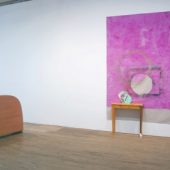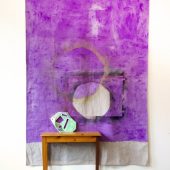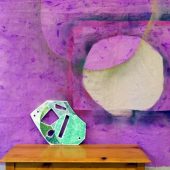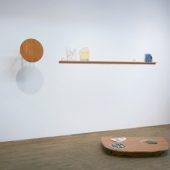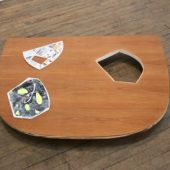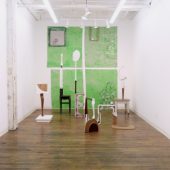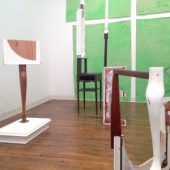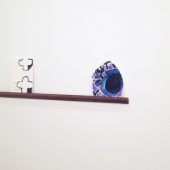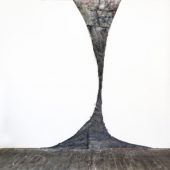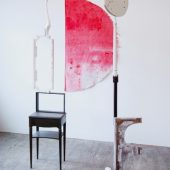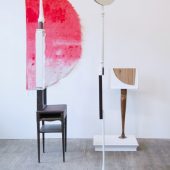01.31 — 03.07.15
Drunken Geometry
Leslie Baum and Allison Wade
January 31 – March 7, 2015
Drunken Geometry is an ongoing collaboration between Leslie Baum and Allison Wade. This iteration of the project engages with the still life genre and its rich history. The table, the ceramic object, the textile–all are foundational elements of still life paintings and materials that figure prominently in Baum’s and Wade’s individual practices. Through these materials, the artists explore their affinities for particular forms and arrangements. Decisions about placement, proximity, and color guide the conversation, as well as a mutual impulse to uncover the sweet spot between object and image, dimensionality and flatness.
Leslie Baum has exhibited in venues nationally and internationally, including exhibitions in Chicago, New York, San Francisco, Rome, and South Korea. Recent exhibitions include Souvenirs From Wonderland at Miami University of Ohio’s Hiestand galleries, Rocket Run at Elder Gallery, Nebraska Wesleyan and 100 Painters of Tomorrow, One Art Space NYC. Her animation short, the Megillat Breakdown, made in collaboration with Frederick Wells, was included in the 2014 Eyeworks Festival. Her drawings and paintings are in the permanent collections of the Chicago Art institute, the Elmhurst Art Museum, and the University of Michigan C.S. Mott Children’s Hospital and Von Voigtlander Women’s Hospital. Her work has been reviewed extensively including in Artforum, Art in America, Hyperallergic, and the Chicago Tribune. She is included in the recently published 100 Painters of Tomorrow. She has received residencies from Yaddo and the Vermont Studio Center. Leslie Baum lives and works in Chicago, Illinois.
lesliebaum.net
Allison Wade is a visual artist working primarily in drawing and sculpture. She received an MFA from the Fiber and Material Studies Department at the School of the Art Institute of Chicago and holds a BA in English literature from Stanford University. Recent solo exhibitions include Thin Troubles at Ditch Projects in Springfield, Oregon, and Conduits and Offerings at the Clough-Hanson Gallery at Rhodes College in Memphis; two-person/group exhibitions include the Riverside Arts Center in Riverside, Illinois, Scotty Enterprises in Berlin, and La Esquina Gallery in Kansas City, among others. Wade has been awarded residencies at Ox-Bow, ACRE, Mustarinda (Finland), and the Vermont Studio Center and has been a visiting artist at Miami University, Rhodes College, and the Cranbrook Academy of Art. Wade lives and works in Chicago, where she is a Lecturer in the Department of Art Theory and Practice at Northwestern University.
allisonwade.com
The following conversation about Drunken Geometry took place between Allison Wade and Leslie Baum in November and December 2014
LB: Look up almost any painter in Google and type in “still life.” You will find an image. This genre of painting seems to be a rite of passage, a thing one works through to get to the next stage, unless of course it is the thing you do, like Morandi. What is appealing and compelling about these images is how intimate and personal they are. It is easy to imagine the arranged objects belonging to the artists, part of the fabric of their daily life. Vases and jugs may not be precious or significant, but they are the concrete stuff of every day. I am interested in the concrete stuff of every day — the bottles, tables, and tablecloths. These are not privileged objects; they are democratic and utilitarian. Though less self important, the moves made in arranging a still life are often the same moves made in an artwork, decisions about placement, proximity, mood, color, form and composition. What does it mean to engage with the genre of still life today? Is it an open window and a breeze? An unselfconscious welcoming of the everyday and the beauty of objects belonging to the home? Is it a stage to play and discover unexpected language and to render the familiar as new and as a surprise? Although our project is built out of the stuff of the still life, does it strive to upend the tradition or to transcend it?
AW: I’m not sure the work has to transcend, or take a vertical stance. Maybe instead it remains horizontal, or extends, like the table, the democratic object. It revels in its orientation. The appeal of the still life to me is the frame. What is our frame and how can we arrange or re-arrange our materials in a way that is pleasing, to us, whether that pleasure comes from the harmony or disharmony? Does the breeze from the open window act on the still life, rendering it the opposite of still, knocking over the arrangement? Or does it highlight the stubbornness, the persistence of these ordered objects — and consequently the still life genre — as the composition remains standing? Maybe this is where the “drunken geometry” comes in — the arrangement gets knocked over, and the remaining pieces, shapes and forms, get re-assembled.
LB: You are right. We do not need to transcend. Extend is far more apt and honest. Oh my yes, the breeze and the open window are chance, the X factor of working with you and you with me.
AW: That’s especially interesting in relation to how our collaboration has evolved over the past year and a half. The X factor keeps changing. The moves we were making last spring are very different from those we are making now. The breeze has shifted directions. These metaphors seem apt, but I keep thinking about what you said the other day — how these recent pieces are “boldly literal” in their deconstruction of the still life.
LB: The metaphors are helpful, expansive, allowing for fresh perspectives on what it is that we are doing, but there is something to the facts of things. The actual materials and how they loop back to announcing themselves first. The tables are tables, the clay is clay and the canvas is fabric. With the still life as an organizing principle, as a conceptual frame, these add up to something more. The still life is an intersection between the object and the image. It is an image constructed of objects. Are we shifting that definition — the image becomes the object? And what about static versus dynamic? In the completed still life painting the objects are fixed, however, it is easy to imagine the arranging happening before the image is committed to canvas. I think what we are doing is bringing that energy, that dynamic quality, into the image, though in our case the image is an installation, the whole crazy project.
AW: I like your observation about the materials announcing themselves. The materials ARE the ground and the image. I think what’s happening is that the materials and forms are asserting themselves equally, or looping back around on each other, as you put it. The white of the clay proclaims its materiality but also subordinates itself to your painted compositions. It is both positive and negative, figure and ground.
LB: Ah, I love that you just interchanged “image” and “form.” Perhaps the way that we are working together and with our own distinct preferences allows for these two oppositional ideas to be of a piece? I realize that I have become very image-oriented of late. I am not convinced that an image has to be flat, but it is something with clarity. Even when it is but a fragment, it asserts its legibility. I am imagining our future installation as an image, even though it will be composed of sculptural works in dialogue with flat pieces.
On another note, this project is like a Venn diagram. You are making the table sculptures because of the parameters of our collaboration and the same is true for my canvas tarp paintings. Both are things we are creating out of things that already exist. The ceramic pieces, however, are different. They are where we overlap, in a boldly literal way. You made the objects by hand and I painted them by hand. I think the facts of this approach to making are interesting; even more exciting is the dialogue between the table sculptures, tarp paintings and ceramic panels.
AW: Exactly…I was also thinking about the fact that the canvas not only references the textile in the still life but the substrate of the still life painting itself. As you pointed out, the canvas relates to how I made the clay slabs. They are flattened on canvas, and that texture remains permanently imprinted on them, whether visible or not.
I’m very interested in your perspective that an image doesn’t have to be flat but it must have clarity to assert its legibility. How are these pieces to be read? Can we suggest a plurality of readings? I’m thinking about the tiles and their originally ambiguous orientation, and how your paintings re-oriented them. When we lay them on a flat surface they are again re-oriented by the viewer. Maybe it makes the project non-denominational?
LB: I am for the plurality of readings and believe we can offer that to the viewer, especially if how we go about arranging these various components is not just formally compelling but also upends some expectations of how they ought to be read or experienced.
I am back to thinking about the Venn diagram and the boldly literal. Completely without conscious intention, I painted a Venn diagram into the purple canvas tarp! I am also thinking about the varying histories of our materials. Clay is of your practice, you have a history of making your work out of clay and the way I went about painting the images on the clay panel is of my practice. I have a history of referencing modern painting in my work. Another Venn diagram! And a little more on the still life paintings: the still life objects that I am referencing on the clay panels don’t seem to have a heavy agenda. They appear refer to the things that are just around the house or studio for perhaps for sentimental, practical, or aesthetic reasons.
AW: I like how you shifted the conversation there. In all honesty for me, and I think for you, this work is agenda-less. It’s about formal play and making connections. The context — deconstruction of the still life, subverting material hierarchy, etc. — is secondary to the experience of the work itself. Not that all of that isn’t important and informative and a generative place to move from and frame the work, but the meat and potatoes of this whole thing are the forms, these new things in the world.
LB: The work does have an agenda. Though it is not the kind of agenda that makes for sexy criticism, copy, or analysis. As you accurately identified, we are engaging in formal play and making connections. We are making within a context, the context of our own practices, for sure, but also within the context of each other and the unexpected challenges, ideas, and possibilities that the other brings to the process. I do think the larger frame is important. Although the still life as a concept, as a historical genre, is not, perhaps, the beating heart, nor fluttering soul of our making, it guides and informs our moves, much as the materials do and the presence of the other does. By the way, I’d like to refine the frame. I think it is a particular kind of still life, the interior/still life no? For us, the room, the space itself, is as important as the tabletop. This is in terms of what we are making, but also it is true for the paintings we are looking at and thinking about. The window, the curtains, the table, the floor, as well as the objects that are so purposely arranged. Maybe our project is the Venn diagram of our individual practices utilizing the still life/interior to focus in on both materials and dialogue with art history?
AW: You are right. Nothing is agenda-less or context-less. I do agree that our agenda is finding what happens when our practices overlap. Making connections. We are operating and talking to/with art history as long as we are calling this art, and the still life as an organizing principle makes perfect sense. I never would have thought about still life in relation to my own practice without your observations. Objects so purposely arranged. The room, the table, the floor. The interior space/setting that acts as the beginning and the end. The frame of the still life gives me permission to use recognizable forms. The table is still a table even when up-ended, but it is now our table.
LB: The beginning and the end. A looping. A circle that wobbles a bit, like a drunk. Our logic and our vocabulary are of this wandering yet insistent geometry.


